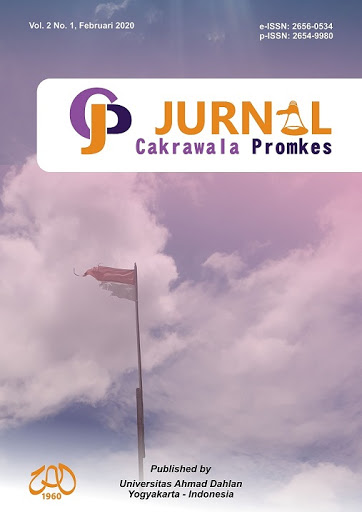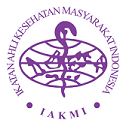Identifikasi masalah kesehatan masyarakat di Desa Banguntapan melalui Data Program Indonesia Sehat Pendekatan Keluarga (PIS-PK)
DOI:
https://doi.org/10.12928/promkes.v3i2.4719Keywords:
Identifikasi masalah, Kesehatan masyarakat, PIS-PKAbstract
Noncommunicable diseases and chronic diseases, such as stroke, hypertension and diabetes mellitus has widely founded in Yogyakarta. In order to, the government has developed a health promotion strategy is the healthy Indonesia through a family program approach or Program Indonesia Sehat dengan Pendekatan Keluarga (PIS-PK). The study aimed to analysis determinant factors of public health problems, to obtain of the health situation and public health service in Ponegaran Hamlet, Banguntapan, Bantul. Descriptive research used to interview instruments as 149 respondents. The analysis method used to determine the priority of health problems is Urgency, Seriousness, Growth(USG). Base on three indicators of PIS-PK which were the main problems were the number of family members who smoker (53%), hypertension who did not take regular medication (71%) and health insurance (34%).
References
Moeloek NF. Indonesia national health policy in the transition of disease burden and health insurance coverage. Medical Journal of Indonesia. 2017 May 16;26(1):3–6.
Collins D, Hafidz F, Mustikawati D. The economic burden of tuberculosis in Indonesia. Int J Tuberc Lung Dis. 2017 01;21(9):1041–8.
Diniawati E, Wibowo A. The Economic Burden and Non-Adherence Tuberculosis Treatment in Indonesia: Systematic Review. KLS. 2019 Feb 28;4(10):17.
Nadjib M, Setiawan E, Putri S, Nealon J, Beucher S, Hadinegoro SR, et al. Economic burden of dengue in Indonesia. PLoS Negl Trop Dis. 2019 Jan 10;13(1).
Haryanto B. Indonesia Dengue Fever: Status, Vulnerability, and Challenges. In: Current Topics in Tropical Emerging Diseases and Travel Medicine. 2018.
Harapan H, Michie A, Mudatsir M, Sasmono RT, Imrie A. Epidemiology of dengue hemorrhagic fever in Indonesia: analysis of five decades data from the National Disease Surveillance. BMC Research Notes. 2019 Jun 20;12(1):350.
Kemenkes RI. Riset Kesehatan Dasar (Riskesdas 2013).Jakarta, Kementerian Kesehatan RI; 2013.
Ni’mah K, Nadhiroh SR. Faktor yang berhubungan dengan kejadian Stunting pada balita A. Media Gizi Indonesia. 2016 Dec 22;10(1):13–9.
Kemenkes RI. Rencana Strategis Kementerian Kesehatan tahun 2015-2019. Jakarta: Kementerian Kesehatan RI; 2015.
Sirait AM, Pradono Y, Toruan IL. Perilaku merokok di Indonesia. Buletin Penelitian Kesehatan. 2002;30(3 Sep).
Cahyo K, Wigati PA, Shaluhiyah Z. Rokok, Pola Pemasaran dan Perilaku Merokok Siswa SMA/Sederajat di Kota Semarang. MEDIA KESEHATAN MASYARAKAT INDONESIA. 2012;11(1):75–85.
Rochayati AS, Hidayat E. Faktor-Faktor Yang Mempengaruhi Perilaku Merokok Remaja di Sekolah Menengah Kejuruan Kabupaten Kuningan. Jurnal Keperawatan Soedirman. 2015 Mar 1;10(1):1–11.
Wiryanatha MA, Ani LS. PERILAKU MEROKOK PADA SISWA LAKI-LAKI SEKOLAH MENENGAH PERTAMA DI WILAYAH KERJA PUSKESMAS SUKASADA II. E-Jurnal Medika Udayana. 2014;3(3).
Rahmadi A, Lestari Y, Yenita Y. Hubungan Pengetahuan dan Sikap Terhadap Rokok Dengan Kebiasaan Merokok Siswa SMP di Kota Padang. Jurnal Kesehatan Andalas. 2013 Jan 1;2(1):25–8.
Park S. Smoking and adolescent health. Korean J Pediatr. 2011 Oct;54(10):401–4.
Wiener RC, Shockey AKT, Morgan SK. Adolescent Light Cigarette Smoking Patterns and Adult Cigarette Smoking. Advances in Epidemiology. 2016;27990461.
Moylan S, Gustavson K, Karevold E, Overland S, Jacka FN, Pasco JA, et al. The Impact of Smoking in Adolescence on Early Adult Anxiety Symptoms and the Relationship between Infant Vulnerability Factors for Anxiety and Early Adult Anxiety Symptoms: The TOPP Study. PLOS ONE. 2013 May 16;8(5):e63252.
Suoth M, Bidjuni H, Malara R. Hubungan gaya hidup dengan kejadian hipertensi di Puskesmas Kolongan Kecamatan Kalawat Kabupaten Minahasa Utara. JURNAL KEPERAWATAN 2014 Feb 28 2(1).
Weber MA, Schiffrin EL, White WB, Mann S, Lindholm LH, Kenerson JG, et al. Clinical Practice Guidelines for the Management of Hypertension in the Community. The Journal of Clinical Hypertension. 2014 Jan 1;16(1):14–26.
Hussain MA, Mamun AA, Reid C, Huxley RR. Prevalence, Awareness, Treatment and Control of Hypertension in Indonesian Adults Aged ≥40 Years: Findings from the Indonesia Family Life Survey (IFLS). PLOS ONE. 2016 Aug 24;11(8):e0160922.
Mboi N. Indonesia: On the Way to Universal Health Care. Health Systems & Reform. 2015 Feb 17;1(2):91–7.
Pisani E, Olivier Kok M, Nugroho K. Indonesia’s road to universal health coverage: a political journey. Health Policy Plan. 2017 Mar 1;32(2):267–76.
Kesuma ZM, Chongsuvivatwong V. Utilization of the Local Government Health Insurance Scheme (JKA) for Maternal Health Services Among Women Living in Underdeveloped Areas of Aceh Province, Indonesia. Asia Pac J Public Health. 2015 Apr 1;27(3):348–59.
Downloads
Published
Issue
Section
License
Copyright (c) 2021 Solikhah Solikhah

This work is licensed under a Creative Commons Attribution-ShareAlike 4.0 International License.
Authors who publish with JCP: Jurnal Cakrawala Promkes agree to the following terms:
- Authors retain copyright and grant the journal the right of first publication with the work simultaneously licensed under a Creative Commons Attribution License (CC BY-SA 4.0) that allows others to share the work with an acknowledgement of the work's authorship and initial publication in this journal.
- Authors are able to enter into separate, additional contractual arrangements for the non-exclusive distribution of the journal's published version of the work (e.g., post it to an institutional repository or publish it in a book), with an acknowledgement of its initial publication in this journal.
- Authors are permitted and encouraged to post their work online (e.g., in institutional repositories or on their website) prior to and during the submission process, as it can lead to productive exchanges, as well as earlier and greater citation of published work.

This work is licensed under a Creative Commons Attribution-ShareAlike 4.0 International License












